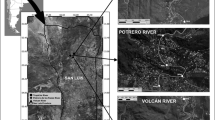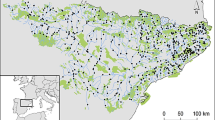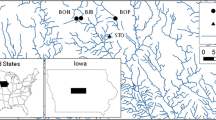Abstract
Watershed acidification and poor water quality can deleteriously affect amphibian populations. Between 1990 and 2008, we sampled 333 small, permanent (inundated year round) waterbodies that drain forested areas in the Algoma, Muskoka and Sudbury regions of central Ontario, Canada to determine whether water chemistry parameters, fish presence, and waterbody area and depth predict amphibian presence or diversity. Amphibians were present in some low-pH waterbodies, contrasting earlier studies, and generally water chemistry was not a strong indicator of amphibian presence or diversity in central Ontario. We suspect that other biotic and abiotic factors have a stronger effect on amphibian presence, and that the relationships between chemical and physical attributes and amphibian presence are complex. Future research should focus on long-term habitat change in central Ontario waterbodies to determine how watershed degradation has affected amphibians.

Similar content being viewed by others
References
Battaglin WA, Smalling KL, Anderson C, Calhoun D, Chestnut T, Muths E (2016) Potential interactions among disease, pesticides, water quality and adjacent land cover in amphibian habitats in the United States. Sci Total Environ 566–567:320–332
Beebee TJC, Griffiths RA (2005) The amphibian decline crisis: a watershed for conservation biology? Biol Conserv 125:271–285
Bradford DF, Gordon MS, Johnson DF, Andrews RD, Jennings WB (1994) Acidic deposition as an unlikely cause for amphibian population declines in the Sierra Nevada, California. Biol Conserv 69:155–161
Burnham KP, Anderson DR (2002) Model selection and multimodel inference: a practical information-theoretic approach, 2nd edn. Springer, New York
Canadian Council of Ministers of the Environment (2004) Phosphorus: Canadian guidance framework for the management of freshwater systems. Environment Canada. http://ceqg-rcqe.ccme.ca/download/en/205
Clark KL (1992) Monitoring the effects of acidic deposition on amphibian populations in Canada. Canadian Wildlife Service Occasional Paper Number 76:44–56
Cook FR (1984) Introduction to Canadian amphibians and reptiles. National Museums of Canada, Ottawa, p 200
Dale JM, Freedman B, Kerekes J (1985) Acidity and associated water chemistry of amphibian habitats in Nova Scotia. Can J Zool 63:97–105
Ficetola GF, De Bernardi F (2004) Amphibians in a human-dominated landscape: the community structure is related to habitat features and isolation. Biol Conserv 119:219–230
Freda J (1986) The influence of acidic pond water on amphibians: a review. Water Air Soil Pollut 30:439–450
Freda J, Sadinski WJ, Dunson WA (1991) Long term monitoring of amphibian populations with respect to the effects of acidic deposition. Water Air Soil Pollut 55:445–462
Glooschenko V, Weller WF, Smith PGR, Alvo R, Archbold JHG (1992) Amphibian distribution with respect to pond water chemistry near Sudbury, Ontario. Can J Fish Aquat Sci 49:114–121
Guderyahn LB, Smithers AP, Mims MC (2016) Assessing habitat requirements of pond-breeding amphibians in a highly urbanized landscape: implications for management. Urban Ecosyst 19:1801–1821
Gunn JM (ed) (2012) Restoration and recovery of an industrial region: progress in restoring the smelter-damaged landscape near Sudbury, Canada. Springer Science & Business Media
Hecnar S, M’Closkey R (1996) Amphibian species richness and distribution in relation to pond water chemistry in South-Western Ontario, Canada. Freshw Biol 36:7–15
Jancowski K, Orchard S (2013) Stomach contents from invasive American bullfrogs Rana catesbeiana (= Lithobates catesbeianus) on southern Vancouver Island, British Columbia, Canada. NeoBiota 16:17–37
Jeffries DS, Clair TA, Couture S, Dillon PJ, Dupont J, Keller W, McNicol DK, Turner MA, Vet R, Weeber R (2003) Assessing the recovery of lakes in southeastern Canada from the effects of acidic deposition. Ambio 32:176–182
Jeziorski A, Yan ND, Paterson AM, DeSellas AM, Turner MA, Jeffries DS, Keller B, Weeber RC, McNicol DK, Palmer ME, McIver K (2008) The widespread threat of calcium decline in fresh waters. Science 322:1374–1377
Jung RE, Jagoe CH (1995) Effects of low pH and aluminum on body size, swimming performance, and susceptibility to predation of green frog (Hyla cinerea) tadpoles. Can J Zool 73:2171–2183
Keller W, Heneberry JH, Edwards BA (2018) Recovery of acidified Sudbury, Ontario Canada, lakes: a multi-decade synthesis and update. Environ Rev 27:1–16
Lacoul P, Freedman B, Clair T (2011) Effects of acidification on aquatic biota in Atlantic Canada. Environ Rev 19:429–460
Likens GE, Driscoll CT, Buso DC (1996) Long-term effects of acid rain: response and recovery of a forest ecosystem. Science 272:244
Longcore JR, Boyd H, Brooks RT, Haramis GM, McNicol DK, Newman JR, Smith KA, Stearns F (1993) Acidic depositions: effects on wildlife and habitats. Wildlife Soc Tech Rev 93–1:42
Mallory ML, Blancher PJ, Weatherhead PJ, McNicol DK (1994) Presence or absence of fish as a cue to macroinvertebrate abundance in boreal wetlands. Hydrobiologia 279/280:345–351
Mallory ML, McNicol DK, Cluis DA, Laberge C (1998) Chemical trends and status of small lakes near Sudbury, Ontario, 1983–1995: evidence of continued chemical recovery. Can J Fish Aquat Sci 55:63–75
McNicol DK, Bendell BE, Ross RK (1987) Studies of the effects of acidification on aquatic wildlife in Canada: waterfowl and trophic relationships in small lakes in northeastern Ontario. Canadian Wildlife Service Occasional Paper Number 62, p 76
McNicol DK, Bendell BE, Mallory ML (1995a) Evaluating macroinvertebrate responses to recovery from acidification in small lakes in Ontario, Canada. Water Air Soil Pollut 85:451–456
McNicol DK, Mallory ML, Wedeles CHR (1995b) Assessing biological recovery of acid-sensitive lakes in Ontario, Canada. Water Air Soil Pollut 85:457–462
McNicol DK, Ross RK, Mallory ML, Brisebois LA (1995c) Trends in waterfowl populations —evidence of recovery from acidification. Ch. 16. In: Gunn J (ed) Restoration and recovery of an industrial region. Springer, New York, pp 205–217
McNicol DK, Mallory ML, Vogel HS (1995d) Using volunteers to monitor the effects of acid precipitation on common loons (Gavia immer) in Canada: the Canadian Lakes Loon Survey. Water Air Soil Pollut 85:463–468
Parris KM (1999) Amphibian surveys in forests and woodlands. Contemp Herpetol 1:1–14
Popescu VD, Patrick DA, Hunter ML, Calhoun AJK (2012) The role of forest harvesting and subsequent vegetative regrowth in determining patterns of amphibian habitat use. Forest Ecol Manage 270:163–174
Symonds MRE, Moussalli A (2011) A brief guide to model selection, multimodel inference and model averaging in behavioural ecology using Akaike’s information criterion. Behav Ecol Sociobiol 65:13–21
Werner EE, Wellborn GA, McPeek MA (1995) Diet composition in postmetamorphic bullfrogs and green frogs: implications for interspecific predation and competition. J Herpetol 29:600
Wetzel RG (1983) Limnology, 2nd edn. Saunders College Publishing, Toronto
Acknowledgements
We thank Dr. Francis Cook and Ross MacCulloch for amphibian species identifications, Environment Canada for water analyses, Don McNicol and numerous field assistants for assistance with the field work, and Elyse Howat for the map. Financial support was provided by Environment Canada and Acadia University. We thank anonymous referees and the BECT Editorial Board for insightful comments on an earlier version of this manuscript.
Author information
Authors and Affiliations
Corresponding author
Electronic supplementary material
Below is the link to the electronic supplementary material.
Rights and permissions
About this article
Cite this article
Loder, A.L., Weeber, R., Wong, S.N.P. et al. Correlates of Waterbody Characteristics and the Occurrence or Diversity of Larval Amphibians in Central Ontario, Canada. Bull Environ Contam Toxicol 103, 571–578 (2019). https://doi.org/10.1007/s00128-019-02698-8
Received:
Accepted:
Published:
Issue Date:
DOI: https://doi.org/10.1007/s00128-019-02698-8




